MoMA PS1 & MAXXI Young Architects Program 2011 - The Winners
By Bustler Editors|
Wednesday, Feb 16, 2011
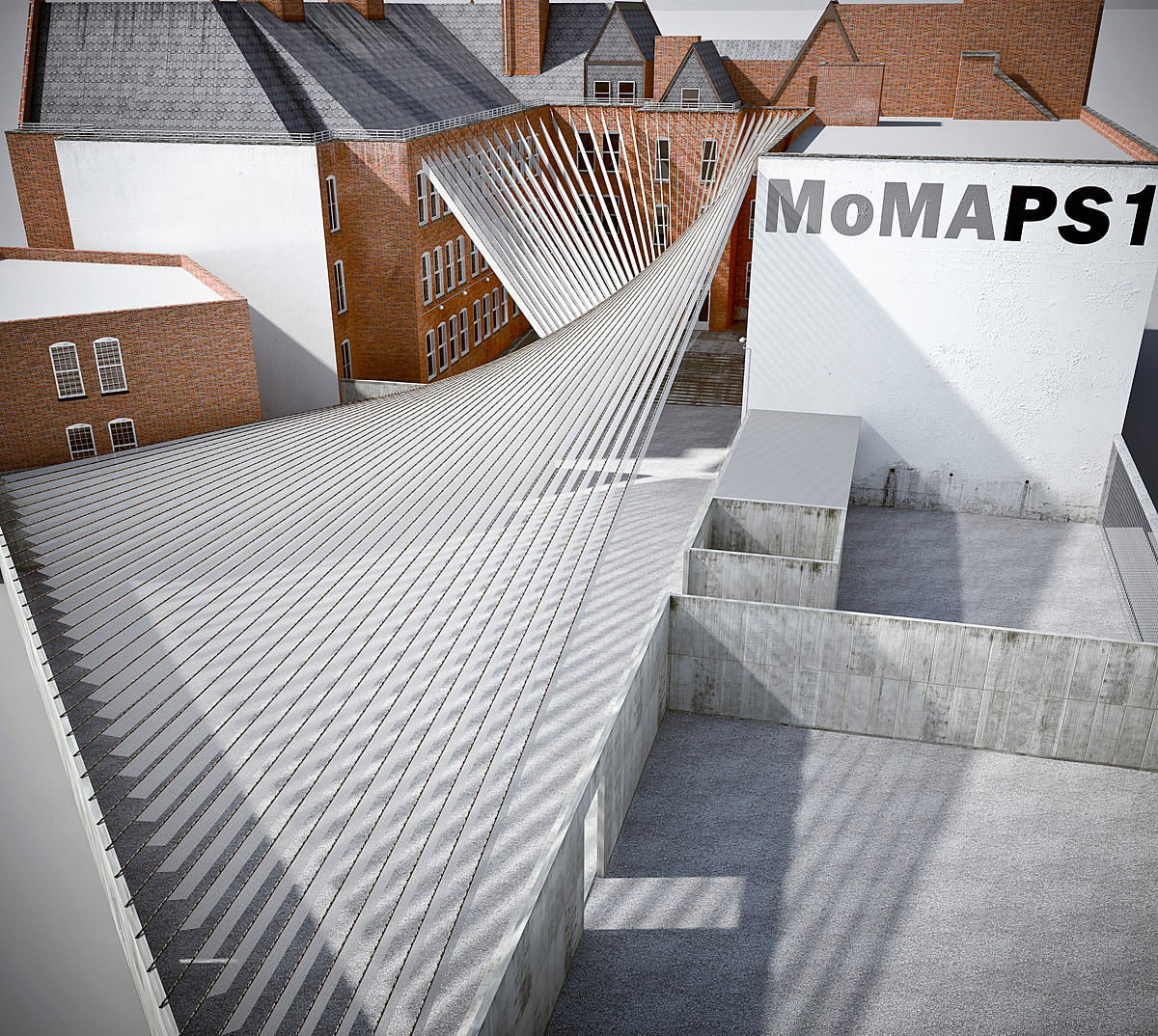
Related
The Museum of Modern Art, MoMA PS1, and the National Museum of XXI Century Arts of Rome just announced Interboro Partners of Brooklyn, NY, as the winner of the 12th annual Young Architects Program in New York, and stARTT, of Rome, as the winner of the first annual YAP_MAXXI Young Architects Program in Rome.
Now in its 12th edition, the Young Architects Program at MoMA and MoMA PS1 has been committed to offering emerging architectural talent the opportunity to design and present innovative projects, challenging each year’s winners to develop highly innovative designs for a temporary, outdoor installation at MoMA PS1 that provides shade, seating, and water. The architects must also work within guidelines that address environmental issues, including sustainability and recycling. For the first time, MoMA and MoMA PS1 are partnering with another institution, MAXXI in Rome, to create the first international edition of the Young Architects Program. Interboro Partners, drawn from among five finalists, will design a temporary urban landscape for the 2011 Warm Up summer music series in MoMA PS1’s outdoor courtyard. stARTT has been chosen from among five European finalists to create an innovative event space in the MAXXI piazza. Both installations will open in June.
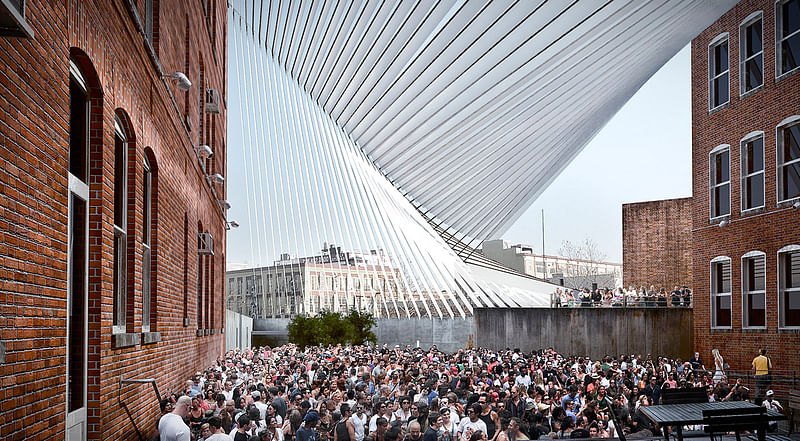
Interboro Partners’ Holding Pattern brings an eclectic collection of objects including benches, mirrors, ping-pong tables, and floodlights, all disposed under a very elegant and taut canopy of rope strung from MoMA PS1’s wall to the parapet across the courtyard. Creating an unobstructed space, the design incorporates for the first time the entire space of MoMA PS1’s courtyard under a single grand structure, while creating an environment focusing on the audience as much as the Warm Up performance. A key component of the theme is recycling; objects in the space will be donated to the community at the conclusion of the summer. The designers met with local businesses and organizations including a taxi cab company, senior and day care centers, high schools, settlement houses, the local YMCA, library, and a greenmarket to determine what components of their installation could be used by those organizations following the Warm Up summer music series. Incorporating objects that can subsequently be used by these organizations is a means of strengthening MoMA PS1’s ties to the local Long Island City community.
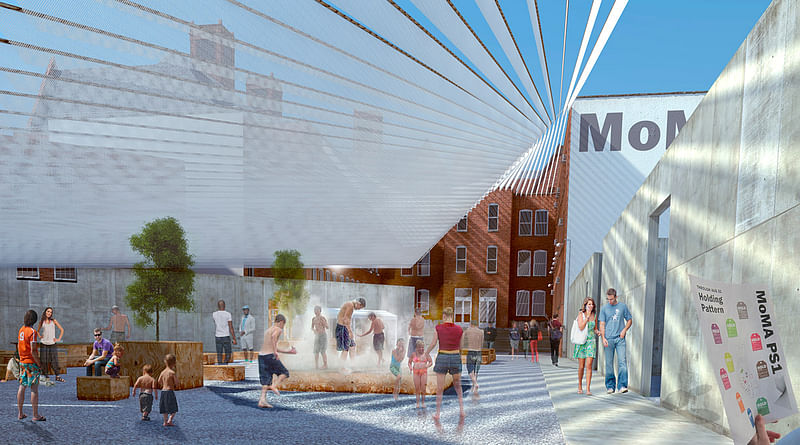
The other finalists for this year’s MoMA PS1 Young Architects Program were FormlessFinder (New Haven, CT/Brooklyn, NY, Julian Rose and Garrett Ricciardi), MASS Design Group (Boston, MA, Michael Murphy), Matter Architecture Practice (Brooklyn, NY, Sandra Wheeler and Alfred Zollinger), and IJP (London/Cambridge, MA, George L. Legendre). An exhibition of the five finalists' proposed projects as well as YAP_MAXXI’s five finalists’ proposed projects will be on view at MoMA over the summer. It will be organized by Barry Bergdoll, MoMA Philip Johnson Chief Curator, with Whitney May, Department Assistant, Department of Architecture and Design, The Museum of Modern Art.
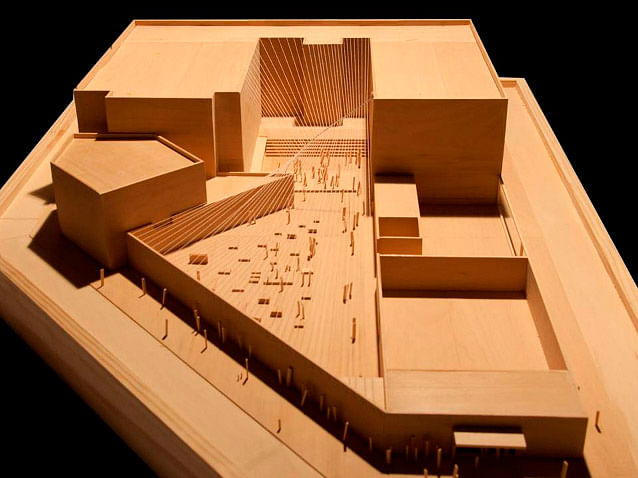
Mr. Bergdoll explains, “Simple materials that transform a space to create a kind of public living room and rec room are trademarks of this young Brooklyn firm. Interboro is interested in creating elegant and unpretentious spaces with common materials. Their work has both a modesty and a commitment quite at odds with the luxury and complex computer-generated form that has prevailed in the city in recent years. With a few gestures they transform parts of the city to achieve new temporary atmospheres and attract new participants.”
Klaus Biesenbach, MoMA PS1 Director and MoMA Chief Curator at Large, adds, “MoMA PS1 is very excited about the innovative architecture of Interboro, which describes the famous MoMA PS1 courtyard as one architectural volume, especially since the YAP 2011 opening will coincide with the much anticipated opening of the new MoMA PS1 entrance kiosk by Andrew Berman Architects."

[UPDATE Feb 23, '11] Project Description of Holding Patterns by Interboro Partners:
REVELATION
"Holding Pattern" is the product of a sustained dialog with MoMA PS1's courtyard and its neighbors. Instead of telling it what it should be, we patiently listened to what it and its neighbors had to say, then responded in kind. The result of this dialog is a scheme doesn't so much redesign the courtyard as reveal it.
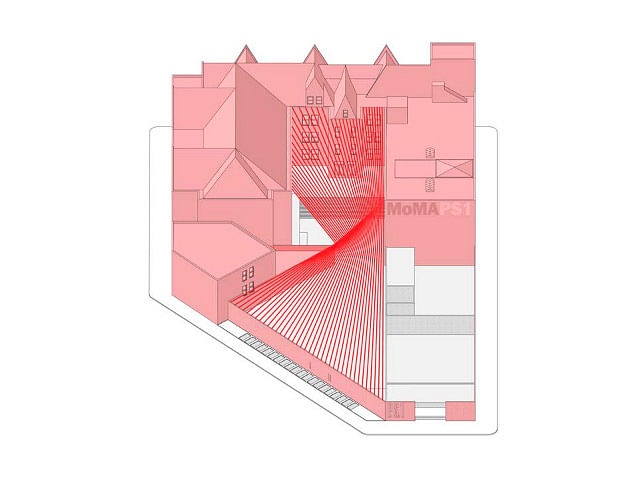
THE ART OF MAKING DO
Time and circumstance had its way with MoMA PS1's courtyard, which in an ideal world would be shaped like a rectangle but which is in reality an irregular seven-sided polygon. Thanks to its neighbor, 2201 Jackson Avenue, which managed to muscle its way into MoMA PS1's courtyard, and to Jackson Avenue itself, which chopped off the block's southwestern corner, Warm Up has had to make do with a very odd, idiosyncratic space. The stairs in front of Warm Up's stage suggest that people should watch the audience instead of the performers, entering the museum feels like being backstage with the band, and the backdoor has been repurposed as the main entry. But as the best baseball stadiums demonstrate, having to make do with less-than-ideal conditions can yield positive outcomes.

"Holding Pattern" reveals this situation by stringing ropes from holes in MoMA PS1's concrete wall to the parapet across the courtyard. In the same way that Hugh Ferris reveals the potential of New York City's 1916 zoning code by drawing the theoretical building envelope, we reveal the very odd, idiosyncratic space of the courtyard and simultaneously create an inexpensive and column-free space for the activity below. From the ground, the experience is of a soaring hyperboloid surface.

TAKIS / TAXIS
Takis is the owner of Checker Management, a taxi cab company located across the street from MoMA PS1. Takis leases 150 cabs to 300 drivers, who show up every day between 4:00 and 6:00 to pick up their cab, gas it up, and perform routine maintenance. In the summer, when the weather is nice, Takis sets up a makeshift outdoor plaza for his employees. The plastic tables, chairs, and tent are used by the drivers to sit, talk, and-on weekends in the summer-watch the throngs of people who pour into MoMA PS1 for the Warm-Up.
"It's not much, but I do what I can to keep my drivers happy," Takis told us.
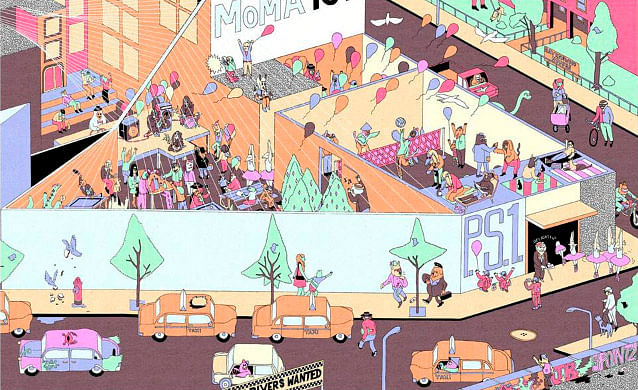
As finalists of MoMA PS1's Young Architect's competition, our task is of course to think about how to keep Warm Up's patrons happy. But as Takis's story suggests, Warm-Up's programmatic requirements seating, shade, and a water feature-sometimes overlap with the needs of Warm Up's neighbors.
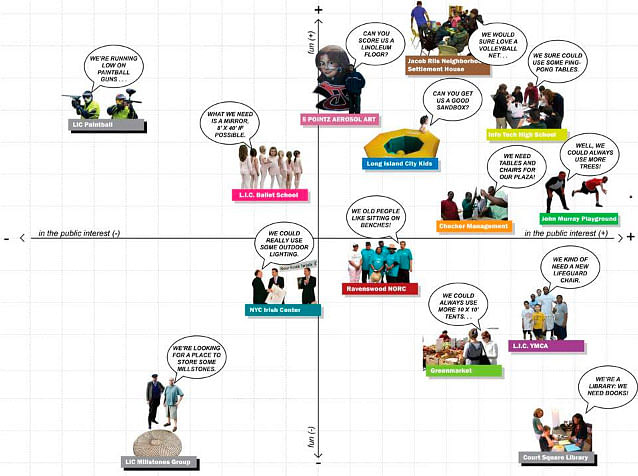
"Holding Pattern" is a new take on recycling. For it, we talked to as many of MoMA PS1's neighbors as we could. In addition to cab drivers, we met with senior and day care centers, high schools, settlement houses, and the local YMCA, library, and greenmarket (to name just a few). We simply asked each one: is there something you need that we could design, use in the courtyard during the Warm Up, then donate in the fall, once the Warm Up is over?
The result is an eclectic collection of objects-including benches, mirrors, ping-pong tables, and flood lights-that we never would have thought to include, but that both enhance the Warm Up's program, and strengthen MoMA PS1's ties to its neighborhood.

Credits:
Tobias Armborst (Principal), Daniel D'Oca (Principal), Georgeen Theodore (Principal), Rebecca Beyer Winik (Project Manager), Kathleen Cahill, Cristobal Correa (Structural Engineer), Andrew Coslow, Jenessa Frey, Lesser Gonzalez, David Himelman, Jenna Kaminsky, Brian Novello, Joel Okpala, Carsten Rodin, Becky Slogeris, Jeff Thompson (Structural Engineer)
Special thanks:
Bancker Construction Corporation, Benjamin Ball, Buro Happold, Hillary Sample, NJIT Modelshop, Valerie Moss (Citibank), Takis (Checker Management) Veronica Franklin, William T. Newlin (Jacob Riis Settlement House), Eric Ragan (LIC Ballet), Irina (LIC Kids), Cedrick Green (YMCA), Chelsea Whittaker (Greenmarket), Meres (5 Pointz Aerosol Art Center), Paul Finnegan (New York Irish Center), Kryss Shane (Ravenswood NORC)
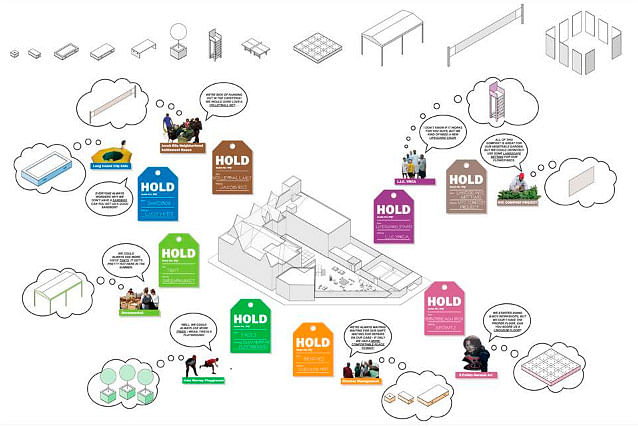
WHATAMI by stARTT is based on the manufacturing of an artificial archipelago-hill, generating smaller green areas in the garden and potentially outside the museum. The hill works as a garden, injecting “green” into the concrete plateau of the museum’s outdoor space, allowing it to serve as a stage and/or parterre for concerts and other events, or as a space to rest and look at the museum itself. The artificial landscape will be punctuated by large “flowers” providing light, shadow, water, and sound. The materials proposed for the installation involve a two-fold recycling process, the supplying of the materials for the construction (straw, geo-textile, plastic) and the dismantling of the “hill” (turf, lighting).
Opened in May 2010, MAXXI was designed by Zaha Hadid and awarded Royal Institute of British Architect’s (RIBA) Stirling Prize for architecture, and has already gained a place among the elite international contemporary art and architecture museums.
The other YAP_MAXXI finalists were Raffaella De Simone/Valentina Mandalari (Palermo); Ghigos Ideas (Lissone/Mi, Davide Crippa, Barbara Di Prete and Francesco Tosi); Asif Khan (London, United Kingdom); and Langarita Navarro Arquitectos (Madrid, Spain, María Langarita and Víctor Navarro).

Pippo Ciorra, Senior Curator of Architecture at MAXXI, explains, “We’re very happy with the results of this program for three main reasons. First, the collaboration with MoMA proved as effective and productive as we hoped, finally allowing us a surprising insight into the most recent research in terms of architecture, public space, and landscape. Second, we were able to discover an unexpected positive quality of answers by the Italian and European young (under 35) architects involved in the project, all proposing fascinating, innovative and well developed proposals. Third, we’re delighted that we were able to choose a winning proposal which incorporates a MAXXI_specific approach to the issues of ecology, recycle, and public space.”
For the Young Architects Program 2011 selection process, MoMA and MoMA PS1 invited outside experts in the field of architecture, including architects, curators, scholars, and magazine editors, to nominate the finalists from a pool of approximately 25 candidates that included both recent graduates and established architects experimenting with new styles or techniques. After reviewing the candidates, five finalists were selected to present proposals to a panel composed of Glenn D. Lowry, MoMA Director; Kathy Halbreich, MoMA Associate Director; Peter Reed, MoMA Senior Deputy Director of Curatorial Affairs; Barry Bergdoll, MoMA Philip Johnson Chief Curator, Department of Architecture and Design; Klaus Biesenbach, MoMA PS1 Director and MoMA Chief Curator at Large; Peter Eleey, MoMA PS1 Curator; Antoine Guerrero, MoMA PS1 Director of Operations and Exhibitions; and Pippo Ciorra, Senior Curator, MAXXI Architettura. The five finalists and winner of the YAP_MAXXI program were selected by a panel composed of Pio Bald, President, Fondazione MAXXI; Margherita Guccione, Director, MAXXI Architettura; Anna Mattirolo, Director, MAXXI Arte; Barry Bergdoll, Philip Johnson Chief Curator of Architecture and Design, The Museum of Modern Art; Klaus Biesenbach, Director of MoMA PS1 and Chief Curator at Large, The Museum of Modern Art, Pippo Ciorra, Senior Curator, MAXXI Architettura; and Maristella Casciato, Associate Professor of History of Architecture, University of Bologna.

Share
0 Comments
Comment as :